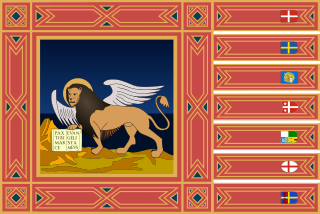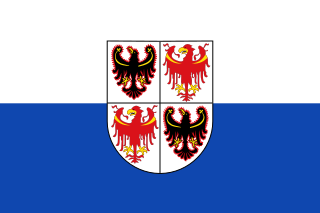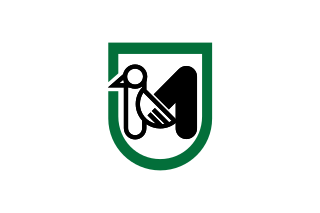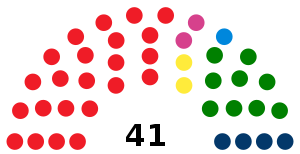
The Politics of Veneto, a Region of Italy takes place in a framework of a semi-presidential representative democracy, whereby the President is the head of government, and of a pluriform multi-party system. Executive power is exercised by the Regional Government. Legislative power is vested in both the government and the Regional Council.

The Politics of Sicily, Italy takes place in a framework of a semi-presidential representative democracy, whereby the President of Regional Government is the head of government, and of a pluriform multi-party system. Executive power is exercised by the Regional Government. Legislative power is vested in both the government and the Sicilian Regional Assembly.

The Politics of Basilicata, takes place in a framework of a presidential representative democracy, whereby the President of Regional Government is the head of government, and of a pluriform multi-party system. Executive power is exercised by the Regional Government. Legislative power is vested in both the government and the Regional Council.

The Politics of Calabria, Italy takes place in a framework of a presidential representative democracy, whereby the President of Regional Government is the head of government, and of a pluriform multi-party system. Executive power is exercised by the Regional Government. Legislative power is vested in both the government and the Regional Council.

The Politics of Trentino-Alto Adige/Südtirol, Italy takes place in a framework of a parliamentary representative democracy, whereby the President of Regional Government is the head of government, and of a pluriform multi-party system. Executive power is exercised by the Regional Government and Legislative power is vested in both the government and the Regional Council. However, since a constitutional reform in 1972, almost all the executive and legislative powers are devolved to the two provinces of which the region is composed: Trentino and the South Tyrol.

The Politics of Apulia,, takes place in a framework of a presidential representative democracy, whereby the President of Regional Government is the head of government, and of a pluriform multi-party system. Executive power is exercised by the Regional Government. Legislative power is vested in both the government and the Regional Council.

The Politics of Lazio, Italy takes place in a framework of a presidential representative democracy, whereby the President of Regional Government is the head of government, and of a pluriform multi-party system. Executive power is exercised by the Regional Government. Legislative power is vested in both the government and the Regional Council.

The Politics of Sardinia (Italy) takes place in a framework of a presidential representative democracy, whereby the President of Regional Government is the head of government, and of a pluriform multi-party system. Executive power is exercised by the Regional Government. Legislative power is vested in both the government and the Regional Council of Sardinia.

The Politics of Lombardy, Italy, takes place in a framework of a semi-presidential representative democracy, whereby the President of the Region is the head of government, and of a pluriform multi-party system. Legislative power is vested in the Regional Council of Lombardy, while executive power is exercised by the Regional Government led by the President, who is directly elected by the people. The current Statute, which regulates the functioning of the regional institutions, has been in force since 2008.

The Politics of Piedmont, Italy takes place in a framework of a presidential representative democracy, whereby the President of Regional Government is the head of government, and of a pluriform multi-party system. Executive power is exercised by the Regional Government. Legislative power is vested in both the government and the Regional Council.

The Politics of Abruzzo takes place in a framework of a presidential representative democracy, whereby the President of Regional Government is the head of government, and of a pluriform multi-party system. Executive power is exercised by the Regional Government. Legislative power is vested in both the government and the Regional Council.

The Politics of Campania takes place in a framework of a presidential representative democracy, whereby the President of Regional Government is the head of government, and of a pluriform multi-party system. Executive power is exercised by the Regional Government. Legislative power is vested in both the government and the Regional Council.

The Politics of Emilia-Romagna, Italy takes place in a framework of a presidential representative democracy, whereby the President of Regional Government is the head of government, and of a pluriform multi-party system. Executive power is exercised by the Regional Government. Legislative power is vested in both the government and the Legislative Assembly.

The regional government of the autonomous region of Friuli Venezia Giulia, Italy, has the form of a presidential representative democracy, where the president of the Region is the head of government, and of a multi-party system. Executive power is exercised by the Regional Government. Legislative power is vested in both the government and the Regional Council.

The Politics of Liguria, Italy takes place in a framework of a presidential representative democracy, whereby the President of Regional Government is the head of government, and of a pluriform multi-party system. Executive power is exercised by the Regional Government. Legislative power is vested in both the government and the Regional Council.

The Politics of Marche, Italy takes place in a framework of a semi-presidential representative democracy, whereby the President of the Region is the head of government, and of a pluriform multi-party system. Legislative power is vested in the Regional Council, while executive power is exercised by the Regional Government led by the President, who is directly elected by the people. The current Statute, which regulates the functioning of the regional institutions, has been in force since 2004.

The Politics of Umbria, one of the 20 regions of Italy, takes place in a framework of a semi-presidential representative democracy, whereby the president of the region is the head of government, and of a pluriform multi-party system. Legislative power is vested in the Legislative Assembly of Umbria, while executive power is exercised by the Regional Cabinet led by the President, who is directly elected by the people. The current statute, which regulates the functioning of regional institutions, has been in force since 2005.

The Politics of Molise, Italy takes place in a framework of a presidential representative democracy, whereby the president of regional government is the head of government, and of a pluriform multi-party system. Executive power is exercised by the regional government. Legislative power is vested in both the government and the Regional Council.

Leonardo Marras is an Italian politician.

The 2020 Tuscan regional election was the 7th regional election held in Tuscany, Italy, and took place on 20 and 21 September 2020. It was originally scheduled to take place on 31 May 2020, but it was delayed due to the coronavirus pandemic in Italy. The Democratic candidate, Eugenio Giani, defeated the League candidate, Susanna Ceccardi. Giani took office as President of Tuscany on October 8, 2020.


































